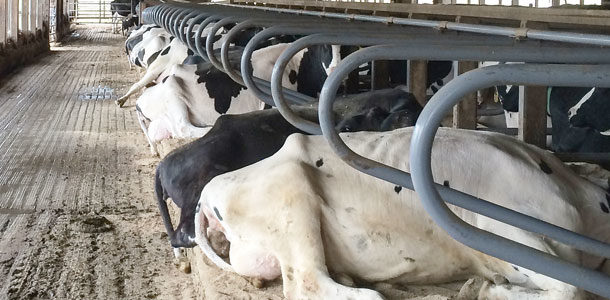Making milk is a lot of work, which is why it is important to provide a comfortable environment for the dairy cow, especially as temperatures rise. In fact, research shows that when cows spends more time resting and ruminating, they are better able to maintain milk production during times of heat stress.
Importance of resting behavior
Dairy cattle have a strong behavioral need for adequate rest, and they are highly motivated to lie down for approximately 11 to 12 hours per day. Obtaining sufficient rest takes precedence over eating and social behavior. In fact, cows will sacrifice eating time to make up for lost resting time.
Physiological function, health and productivity are impaired when the resting requirement is not met. Cows with restricted lying time have greater serum cortisol and lower growth hormone concentrations, impaired hoof health and locomotion, and sometimes lower milk yield. On average, you can expect about 2 to 3.5 pounds more milk per cow daily when enhanced cow comfort results in one more hour of lying time.
Cow responses to heat stress
High-producing cows can become heat-stressed at a temperature-humidity index (THI) of only 68. Heat stress is associated with several important behavioral, productive and health changes in dairy cattle. As air temperature increases from about 78 to 104ºF, eating decreases by 46 percent, ruminating decreases by 22 percent, standing increases by 34 percent, drinking increases by 30 percent and locomotion decreases by 19 percent.
Cows producing more than 70 pounds of milk per day are typically more sensitive to heat stress than lower-producing cows, especially when it comes to resting and standing activity. Unabated heat stress reduces feed intake by up to 35 percent or more.
Even on well-managed dairies, heat stress can easily reduce intakes by 10 to 15 percent. Milk yield is often reduced by up to 50 percent under conditions of severe heat stress, and even when cooling is used, milk production decreases of up to 20 percent are too common.
In addition to these immediate effects, cows typically lose bodyweight and condition during prolonged periods of heat stress. The negative carryover effects of heat stress on reproduction can persist well into the cooler fall months. Even relatively mild to moderate heat stress can boost lameness, according to Wisconsin research.
Body temperature and lying activity
Body temperature mediates the cow’s standing and lying response to varying conditions of heat stress. Cornell researchers found that during heat-stress conditions, core body temperature appears to control whether the cow lies down or stands.
The cow will stand up once her temperature reaches around 102ºF and won’t lie back down again until her core body temperature reaches around 100.9ºF. Research published in 2015 by Arizona and Missouri researchers confirmed that cows with elevated core body temperatures stood longer and rested less.
Cooled cows lie down and ruminate more
The best way to get a heat-stressed cow to lie down in a comfortable stall and make more milk is to cool her body temperature. Because highly productive cows become heat-stressed at a THI of 68 or so, we need to employ more aggressive and creative heat stress abatement strategies than traditionally used. Increasingly, the focus of heat abatement needs to be in both the resting and feeding areas.
We have observed greater resting time in the stalls and more rumination during occasional bouts of heat stress when we compared a heat abatement system that cooled cows in the stalls with fans and water in addition to the more typical cooling over the feed alley. Fans and sprinklers over the feed alley will cool the cow, but there is also the risk that cows will spend too much time standing in the feed alley in an attempt to cool themselves.
If cows loiter in the feeding area without eating, then they are likely to be short-changing the time they need to spend lying down in a comfortable stall. From the cow’s biological viewpoint, a system that could effectively cool over the stalls and the feed line ought to be ideal.
Then, we could optimize both feeding and resting behavior. And as a result of that, rumination would also be improved since it is positively related to feed intake and resting. We intend to conduct more research this summer to compare the longer-term impact of effective cow cooling in stalls to enhance the ordinary cooling over the feedbunk.
The bottom line
We know that cows become heat-stressed at a THI of only 68 with reductions in resting, rumination, feed intake and milk production. As the cow’s core body temperature rises, she stands in an effort to speed cooling – and she’s not likely to lie down again until her temperature is lowered. Resting is the cow’s most valued behavior, and we must do an effective job of cow cooling to get her into the stall and lying down so that her resting requirement is met. PD
PHOTO
We know that cows become heat-stressed at a THI of only 68 with reductions in resting, rumination, feed intake and milk production. As the cow’s core body temperature rises, she stands in an effort to speed cooling – and she’s not likely to lie down again until her temperature is lowered. Photo courtesy of Rick Grant.

Rick Grant
President
William H. Miner Agricultural Research Institute






